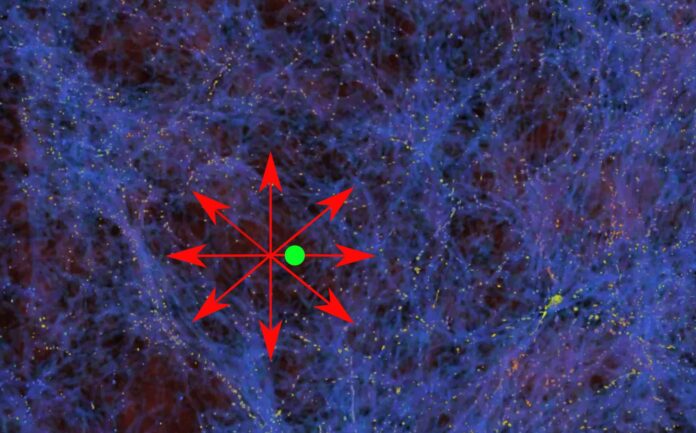The longstanding puzzle of the Hubble tension may finally be solved. A groundbreaking study by the Universities of Bonn and St. Andrews offers a novel solution to the Hubble tension, suggesting a modified theory of gravity could explain the varying measurements of the universe’s expansion rate.
This “Modified Newtonian Dynamics” May Resolve One of the Great Mysteries of Cosmology, According to New Calculations
The cosmos is in a state of perpetual expansion, a phenomenon quantified by the Hubble-Lemaitre constant. However, the precise value of this constant is hotly debated, as various measurement methods yield conflicting results.
This issue, known as the “Hubble tension,” challenges cosmologists’ understanding of the universe’s growth rate. A new proposition from researchers at the Universities of Bonn and St. Andrews may hold the key to resolving this discrepancy.
They suggest that an alternative gravitational theory could reconcile the differing measurements, potentially resolving the Hubble tension.
This innovative approach was recently detailed in the Monthly Notices of the Royal Astronomical Society (MNRAS).
As galaxies drift apart, their separation speed is directly proportional to their distance, a relationship initially recognized by American astronomer Edwin Hubble. The Hubble-Lemaitre constant is crucial for calculating the rate of this galactic recession.
Current estimates place this speed at approximately 244,000 kilometers per hour for every megaparsec of distance (a megaparsec equals just over three million light years).
Yet, closer astronomical observations, particularly of Type 1a supernovae, indicate a higher speed—about 264,000 kilometers per hour per megaparsec.
“The universe therefore appears to be expanding faster in our vicinity – that is, up to a distance of around three billion light years – than in its entirety,” explains Prof. Dr. Pavel Kroupa from the Helmholtz Institute of Radiation and Nuclear Physics at the University of Bonn. “And that shouldn’t really be the case.”
New calculations hint at a solution.
Earth appears to be in a sparse matter region, similar to a bubble in a cosmic cake, surrounded by denser matter. Surrounding this ‘bubble,’ the matter is denser, exerting gravitational forces that influence the movement of galaxies within this low-density area.
Dr. Indranil Banik from St. Andrews University adds, “That’s why they are moving away from us faster than would actually be expected,” suggesting a local “under-density” as the cause.
In support of this theory, another research team observed the movement of galaxies located about 600 million light years away. They discovered these galaxies are receding at a rate four times greater than what the standard cosmological model predicts, as explained by Sergij Mazurenko of Kroupa’s research team.
This finding challenges the standard model of cosmology, which does not account for such low-density regions or ‘bubbles’ in space. The model, based on Einstein’s theory of gravity, assumes a uniform distribution of matter throughout the universe. However, the observed high speeds of galaxies in certain regions are difficult to reconcile with this model.
According to recent research, Earth is situated in a unique region of space, akin to an air bubble within a cake, where the density of matter is notably sparse. Surrounding this ‘bubble,’ the matter is denser, exerting gravitational forces that influence the movement of galaxies within this low-density area. Dr. Indranil Banik from St. Andrews University explains that these gravitational forces cause galaxies in this region to recede from us more rapidly than previously anticipated, suggesting a local “under-density” as the cause.
In support of this theory, another research team observed the movement of galaxies located about 600 million light years away. They discovered these galaxies are receding at a rate four times greater than what the standard cosmological model predicts, as reported by Sergij Mazurenko of Kroupa’s research team.
This finding challenges the standard model of cosmology, which does not account for such low-density regions or ‘bubbles’ in space. The model, based on Einstein’s theory of gravity, assumes a uniform distribution of matter throughout the universe. However, the observed high speeds of galaxies in certain regions are difficult to reconcile with this model.
In response, the research groups from the Universities of Bonn and St. Andrews turned to an alternative gravitational theory known as ‘modified Newtonian dynamics’ (MOND), originally proposed by Israeli physicist Prof. Dr. Mordehai Milgrom. Though not widely accepted, MOND predicts the existence of these under-dense ‘bubbles’ in the universe.
Using computer simulations based on MOND, they found that if gravity behaves as Milgrom theorized, it could resolve the discrepancies in the universe’s expansion rate.
“In our calculations, however, MOND does accurately predict the existence of such bubbles,” adds Kroupa.
This would imply that there is indeed a single, uniform constant governing the expansion of the universe, with the observed variations being attributed to irregularities in matter distribution.
Image Credit: AG KROUPA/UNIVERSITY OF BONN
